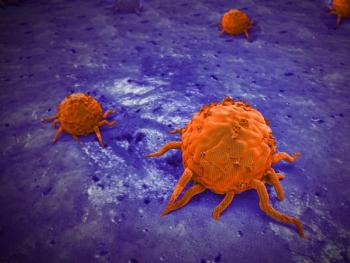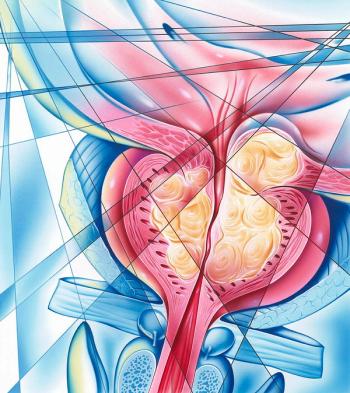
Ensartinib Yields Superior Efficacy Over Crizotinib for ALK-Positive Non–Small Cell Lung Cancer
Results from the phase 3 eXalt3 study indicated that ensartinib led to a longer progression-free survival and intracranial response rate compared with crizotinib for patients with ALK-positive non-small cell lung cancer.
Ensartinib (X-396) demonstrated superior efficacy vs crizotinib (Xalkori) in terms of systemic and intracranial disease in patients with ALK-positive non–small cell lung cancer (NSCLC), according to data from the phase 3 eXalt3 study (NCT02767804) study published in JAMA Oncology.
Investigators reported a median progression-free survival (PFS) of 25.8 months (range, 0.03-44.0) in the intent-to-treat population for ensartinib compared with 12.7 months (range, 0.03-38.6) for crizotinib (HR, 0.51; 95% CI, 0.35-0.72; P< .001). Additionally, an objective response rate (ORR) of 74% (95% CI 66%-81%) in the ensartinib cohort and 67% (95% CI, 58%-74%) in the crizotinib cohort was reported. The median duration of response was not reached in the ensartinib arm (95% CI, 22.0 months–not reached [NR]) and was 27.3 months (95% CI, 12.9 months-NR) in the crizotinib arm. The intracranial response rate was 63.6% with ensartinib and 21.1% with crizotinib.
In order to be eligible for enrollment, patients needed to be 18 years or older with advanced, recurrent, or metastatic ALK-positive NSCLC. Measurable disease by RECIST 1.1 criteria was also required.
A total of 290 patients were enrolled on the global, open label, multicenter study and were randomized 1:1 into either the ensartinib group (n = 143) or the crizotinib group (n = 147). Patients were stratified based on prior treatment with chemotherapy, ECOG performance status, central nervous system metastases, and geographic region. Patient were treated with either 225 mg of oral ensartinib once daily or 250 mg of crizotinib twice daily. At baseline, 32.9% (n = 47) of patients in the ensartinib group and 38.8% (n = 57) in the crizotinib group had brain metastases.
Within the modified intent-to-treat population, 247 patients were randomized based on the results of local testing for ALK with central confirmation (n = 112) or positive central testing for ALK (n = 135). A total of 43 patients were excluded from the intent-to-treat population due to having insufficient samples (n = 27), uninterpretable findings (n = 7), or negative results on the local ALK test (n = 9). Following exclusions, the intent-to-treat population included 121 patients in the ensartinib group and 126 in the crizotinib group.
The median follow-up was 23.8 months in the ensartinib group and 20.2 months in the crizotinib group. As of July 2020, 44.8% (n = 64) and 17.0% (n = 25) of patients in the ensartinib and crizotinib groups, respectively, are actively undergoing treatment.
The subgroup analysis indicated that among patients who had not previously been treated with chemotherapy in the ensartinib cohort, the median PFS was not reached (95% CI, 20.2-NR) and was 11.1 months (95% CI, 7.8-16.6) in the crizotinib cohort. Additionally, patients in the ensartinib group who received prior chemotherapy had a median PFS of 22.0 months (95% CI, 10.9-NR) and 12.8 months (95% CI, 5.5 months-NR) in the crizotinib group. The confirmed ORR within the modified intent-to-treat group was 75% (95% CI, 66.5%-82.6%) in the ensartinib arm and 68% (95% CI, 58.5%-75.5%) in the crizotinib arm, with complete responses being more than 2-fold higher in the ensartinib group (14%; 95% CI, 8.4%-21.5%) vs the crizotinib group (6%; 95% CI, 2.3%-11.1%). The median duration of response was not reached in the ensartinib group, with 59% (95% CI, 45%-70%) of patients experiencing a durable response lasting 36 months or more.
A total of 11 patients in the ensartinib arm and 19 patients in the crizotinib arm had measurable brain metastases. Among this group, 63.6% (n = 7) of patients in the ensartinib group had change in brain lesions compared with 21.1% (n = 4) in the crizotinib group. PFS without brain metastases was not reached among those being treated with ensartinib compared with 16.6 months for crizotinib.
At 12 months, 4.2% of patients in the ensartinib group compared with 23.9% in the crizotinib group developed brain metastases (HR, 0.32; 95% CI, 0.16-0.63; P = .001). Additionally, at 36 months, 61% of patients in the ensartinib group were disease free compared with 25% of patients in the crizotinib group. The median PFS for patients with brain metastases at baseline in the ensartinib group was 11.8 months (95% CI, 5.5 months-NR) and 7.5 months (95% CI, 5.5-9.3 months) in the crizotinib group.
In the modified intent-to-treat population, 30 patients in the ensartinib group and 32 patients in the crizotinib group died (HR, 0.91; 95% CI, 0.54-1.54). Patients has a 2-year overall survival (OS) rate of 78% (95% CI, 69%-84%) in the ensartinib group and 78% (95% CI, 70%-85%) in the crizotinib group. The median OS was not reached in either group.
Grade 3 rash occurred in 11.2% of patients, and was managed by dose reducing and withholding the dose. In relation to treatment of ensartinib, the only reported grade 3 and 4 adverse effects (AEs) were increased bilirubin level, increased creatin phosphokinase level, and hyponatremia.
Treatment-related AEs that were associated with dose reduction occurred in 23.8% (n = 34) of patients in the ensartinib group and 19.9% (n = 29) of those in the crizotinib group. Patients also experienced AEs that led to discontinuation treatment with ensartinib, including liver enzymes (n = 12), pneumonitis (n = 2), chest pain (n = 1), and pyrexia (n = 1). Bo treatment-related deaths were reported.
Reference
Horn L, Wang Z, Wu G, et al. Ensartinib vs crizotinib for patients with anaplastic lymphoma kinase-positive non-small cell lung cancer: a randomized clinical trial. JAMA Oncol. Published Online September 2, 2021. doi:10.1001/jamaoncol.2021.3523
Newsletter
Stay up to date on recent advances in the multidisciplinary approach to cancer.


















































































